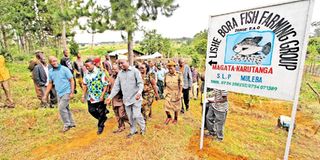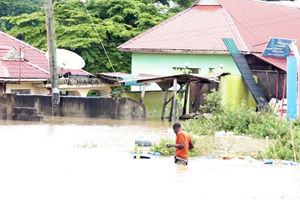Kagera turning into producer of cassava

Kagera Regional Commissioner Major General (rtd) Salim Kijuu (centre) is flanked by officials during a past tour. PHOTO | FILE
What you need to know:
The Kagera RC says they were already mulling over establishing cassava-processing factories in the region, a move that will help farmers generate more income
Bukoba. Cassava farming is gaining momentum in Kagera region, especially after the north-western region was hit by an earthquake in 2016, which caused colossal effects on the livelihood of the people.
This is a good initiative, which has prompted Kagera Regional Commissioner (RC), Major General (retired) Salim Kijuu, to mull over establishment of cassava-processing factories in the region, a move that will help farmers generate more income.
According to him, the region is already looking for ways to raise money, which will serve as the working capital. It will also be used to purchase new machinery.
This, he said, aims at raising cassava-flour production, which would help in boosting food security, jobs creation, farmers’ earnings and improvement of their wellbeing.
According to the commissioner, one of the main obstacles he sees the cassava farmers are grappling with is how to market their products, something which would help in guaranteeing their incomes.
The retired Major General says there is a reliable market in the neighbouring countries where the demand for cassava flour is high, calling on people to increase the production of the crop.
“We can even get lucrative markets in Dar es Salaam where 250 tonnes of cassava are sold daily. It is a big market, but it can still take more tonnes,” he said.
Mr Kijuu said with increased production of the crop, they will be able to export flour to the neighbouring countries.
According to him, the factory, which would be established, will help empower local cassava farmers who will have access to more profitable markets for their products in different countries.
Mr Kijuu praised the excellent partnership, technical and financial support of FAO, which is changing the lives of a lot farmers in all earthquake-hit areas.
The support in securing technical assistance in the entire value-chains of crops will enable people get enough and nutritious food.
For many, the memories of the tragic earthquake are still fresh. A total of 19 people lost their lives with 253 others injured in Kagera on September 10, 2016. Most of the casualties occurred in Bukoba.
On September 12, the same year, the office of the Prime Minister Kassim Majaliwa reported that at least 840 houses were destroyed by the quake with other 1,264 seriously damaged, rendering thousands of people homeless.
In implementing the recommendations from the report of the study team from the Prime minister’s Office, the Kagera Regional Commissioner’s office and affected districts teamed up with the UN Food and Agriculture Organisation (FAO) to execute a special programme on strengthening resilience of agriculture systems in the Region.
Following the quake, which destroyed properties, which mainly belonged to farming communities, FAO made some timely interventions that have helped groups of people to go back to farming, livestock keeping and fishing activities.
So far, says Mr Kijuu, about 5,000 households in five councils namely Muleba, Kyerwa, Bukoba Rural, Misenyi, and Bukoba Municipality are reaping big from the programme.
District Commissioners (DCs) and District Executive Directors (DEDs) in the same region have been directed to ensure that there is close supervision in implementation of the programme.
The councils have also set aside funds for buying seeds and urged people to plant fast-maturing food crops including sweet potatoes, maize, bananas and cassava.
FAO Representative Fred Kafeero visited the region a few weeks ago and was pleased with positive outcomes and the enthusiasm of the farmer and those supervising the project.
Mr Kafeero was contented to learn that the two year-programme that has cost $299,000 is scaling-up good agricultural practices and other modern agriculture approaches to enhance productivity.
“The project is reducing the impact of climate related risks to farmers and shall eventually enable them run their daily lives better prepared,“ says Kafeero.
He adds that FAO aims at seeing the local people affected by the earthquake in some parts of Kagera to have sufficient nutritious food and also sell the surplus to get income to meet other needs in life, including paying school fees for their children.
At Nshambya area, for instance, Rashana groups with 17 members run a demonstrative cassava farm where 700 families will later on be instructed on how to run a profitable cassava farming project.
Chairperson of the group Modesta Mjaki thanked FAO for giving them the right technology of planting cassava and how to take care of it as it grows. Ms Njaki remains optimistic that they will have a bumper harvest because of proper advice they have received from extension officers.
In Missenyi District where the quake also wreaked havoc, joint efforts by FAO and regional authorities have yielded some good results. The introduction of good agricultural practices have enabled people to get enough food and surplus for sale.
Over 20 groups have been helped to start cassava and beans farms, poultry, and potato farms in Minziro, Nankere and Mikono villages, which are experiencing low rainfall due to climatic changes.
Mr Kafeero urged farmers to apply moidern ways of tilling their farms and plant drought-resistant improved seeds, stressing that the best way to fight climate change is to apply modern irrigation technologies.
She added that FAO is ready to offer technical support.
Under the financial backing of FAO, the Maruku Agriculture Research Institute has developed some improved cassava, sweet potatoes, and beans seeds which are drought resistant and can grow well in all the areas that were affected by the earthquake.
Dr Magdalena William, famously known in Maruku area as ‘Mama Maharage’ has done a great job in developing three different types of improved bean seeds rich in iron and zink and farmers who planted them got good harvests.
An impressive demonstrative maize farm at Mayole village in Nyabushozi area has helped farmers learn in practice how to plant maize profitably to enable villagers to get enough food for their families, as well as for sale.




